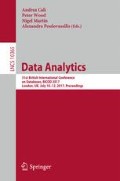Abstract
Opportunities for replicating large data sets that have already been collected by government, and made available to the public to provide the possibility of statistical data analysis, are starting to emerge. This study examines the factor structure of ambidextrous culture for innovation. Survey data was extracted from the State of the Service Employee Census 2014 comprising 3,125 engineering professionals in Commonwealth of Australia departments. Data were analysed using exploratory factor analysis (EFA) and confirmatory factor analysis (CFA). EFA returned a two-factor structure explaining 61.1% of the variance of the construct. CFA revealed that a two-factor structure was indicated as a validated model (GFI = 0.99, AGFI = 0.98, RMSEA = 0.05, RMR = 0.02, IFI = 0.99, NFI = 0.99, CFI = 0.99, and TLI = 0.98). From the results, the two factors extracted as characterising ambidextrous culture for innovation were innovative culture and performance-oriented culture.
Access this chapter
Tax calculation will be finalised at checkout
Purchases are for personal use only
References
Hair, J.F., et al.: Multivariate data analysis: A global perspective. Basım Pearson Education (2010)
Gerbing, D.W., Anderson, J.C.: An updated paradigm for scale development incorporating unidimensionality and its assessment. J. Marketing Res. 25, 186–192 (1988)
Kline, R.B.: Principles and Practice of Structural Equation Modeling. Guilford Publications, New York (2015)
Zhou, K.Z., et al.: Developing strategic orientation in China: antecedents and consequences of market and innovation orientations. J. Bus. Res. 58(8), 1049–1058 (2005)
Lægreid, P., Roness, P.G., Verhoest, K.: Explaining the innovative culture and activities of state agencies. Organ. Stud. 32(10), 1321–1347 (2011)
Vartanian, T.P.: Secondary Data Analysis. Oxford University Press, New York (2010)
Brown, R.B., Saunders, M.P.: Dealing with Statistics: What you Need to Know. McGraw-Hill Education, UK (2007)
Frankfort-Nachmias, C., Nachmias, D.: Research Methods in the Social Sciences, 7th edn. Worth, New York (2008)
Torugsa, N., Arundel, A.: Complexity of Innovation in the public sector: a workgroup-level analysis of related factors and outcomes. Public Manag. Rev. 18(3), 392–416 (2016)
Torugsa, N.A., Arundel, A.: The nature and incidence of workgroup innovation in the Australian public sector: evidence from the Australian 2011 state of the service survey. Australian J. Public Adm. 75(2), 202–221 (2015)
Tabachnick, B.G., Fidell, L.S.: Using Multivariate Statistics. Allyn & Bacon, Needham Height, MA (2007)
Russell, D.W.: In search of underlying dimensions: the use (and abuse) of factor analysis in Personality and Social Psychology Bulletin. Pers. Soc. Psychol. Bull. 28(12), 1629–1646 (2002)
Pallant, J: SPSS Survival Manual: A Step by Step Guide to Data Analysis Using IBM SPSS. McGraw-Hill, Maidenhead (2013)
Field, A.: Discovering Statistics Using IBM SPSS Statistics, 4th edn. SAGE Publications, London (2013)
O’connor, B.P.: SPSS and SAS programs for determining the number of components using parallel analysis and Velicer’s MAP test. Behav. Res. Methods Instrum. Comput. 32(3), 396–402 (2000)
Gallagher, D., Ting, L., Palmer, A.: A journey into the unknown; taking the fear out of structural equation modeling with AMOS for the first-time user. Mark. Rev. 8(3), 255–275 (2008)
Byrne, B.M.: Structural Equation Modeling with AMOS: Basic Concepts, Applications, and Programming. Routledge, New York (2013)
Bagozzi, R.P., Yi, Y.: On the evaluation of structural equation models. J. Acad. Mark. Sci. 16(1), 74–94 (1988)
Podsakoff, P.M., et al.: Common method biases in behavioral research: a critical review of the literature and recommended remedies. J. Appl. Psychol. 88(5), 879 (2003)
Author information
Authors and Affiliations
Corresponding author
Editor information
Editors and Affiliations
Rights and permissions
Copyright information
© 2017 Springer International Publishing AG
About this paper
Cite this paper
Wipulanusat, W., Panuwatwanich, K., Stewart, R.A. (2017). Statistical Data Analysis of Culture for Innovation Using an Open Data Set from the Australian Public Service. In: Calì, A., Wood, P., Martin, N., Poulovassilis, A. (eds) Data Analytics. BICOD 2017. Lecture Notes in Computer Science(), vol 10365. Springer, Cham. https://doi.org/10.1007/978-3-319-60795-5_7
Download citation
DOI: https://doi.org/10.1007/978-3-319-60795-5_7
Published:
Publisher Name: Springer, Cham
Print ISBN: 978-3-319-60794-8
Online ISBN: 978-3-319-60795-5
eBook Packages: Computer ScienceComputer Science (R0)

